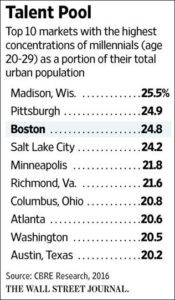 My apologies if I sound like a broken record, but clearly there are people who still don’t get the message. So, here I go again… Today’s Wall Street Journal interviews GE’s chief financial officer, Jeffrey Bornstein, on how the move of the conglomerate’s headquarters from suburban Connecticut to Boston is working out.
My apologies if I sound like a broken record, but clearly there are people who still don’t get the message. So, here I go again… Today’s Wall Street Journal interviews GE’s chief financial officer, Jeffrey Bornstein, on how the move of the conglomerate’s headquarters from suburban Connecticut to Boston is working out.
I reproduce select quotes from Bornstein below. As you read them, keep in mind the chart to the left. Richmond ranks 6th among the top ten markets in the country with the highest concentrations of millennials as a percentage of the urban population. Think about where walkable, mixed-use urban development is occurring in the metropolitan region, and where it is not occurring. (Hint, almost all of it is occurring in the city of Richmond and almost none of it in Henrico, Chesterfield or Hanover counties.)
There were moments in the past when we really asked ourselves whether Connecticut made sense for the company. There wasn’t a huge ecosystem around the company. We lived on a very beautiful property in Fairfield, but very isolated. Attracting talent there was a bit of a challenge. For younger folks maybe not the most dynamic place in the world. …
There are upward of 500,000 kids who go to school—undergrad and graduate school, doctorate—every day here in greater Boston. …
There definitely is an innate culture and tactical depth and talent here. It lends itself to these kind of entrepreneurial endeavors. The universities here, whether it’s MIT, Northeastern, Harvard, you name it…the proximity allows us to build even deeper relationships with these institutions. …
If you saw where we were in Fairfield County, it was a morgue. Very little activity. I hated it. Even in our temporary space, the offices are open. There’s a lot more interaction. You aren’t calling people who are four offices away. You can get up and go, and physically grab the folks. We’re translating those experiences to the new facility. It will be very modern, green and open. …
Millennials, this is the kind of environment they want to work in. They don’t want to work in the environment that was paneled walls, and, based on your level in the company, you could count the ceiling tiles and that determined the size of your office. That’s the world of the ’70s, ’80s, maybe the early ’90s. Young talent today want to be in a vibrant, open, interactive, high-tech, fun kind of space. That’s how we thought about design in the new facility. …
From the get-go we knew we wanted to be in a place that was vibrant and entrepreneurial, where you could walk out your door enriched by your environment and your ecosystem. I can walk out my door and visit four startups. In Fairfield, I couldn’t even walk out my door and get a sandwich. We knew we wanted to be in a more urban environment where we could actually participate in the ecosystem and be smarter and more aware as a result.
(Hat tip: Chris Spencer.)


